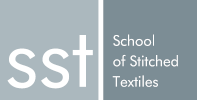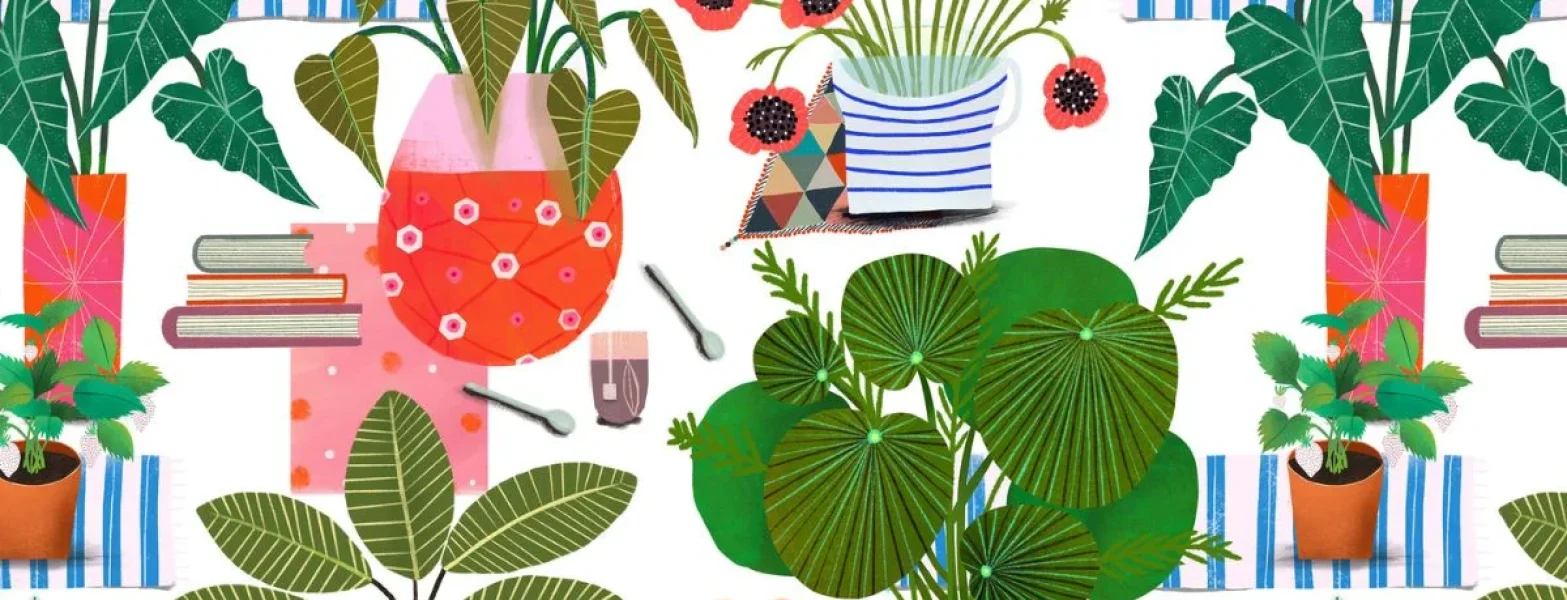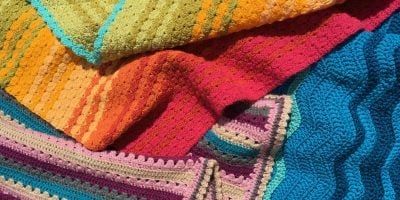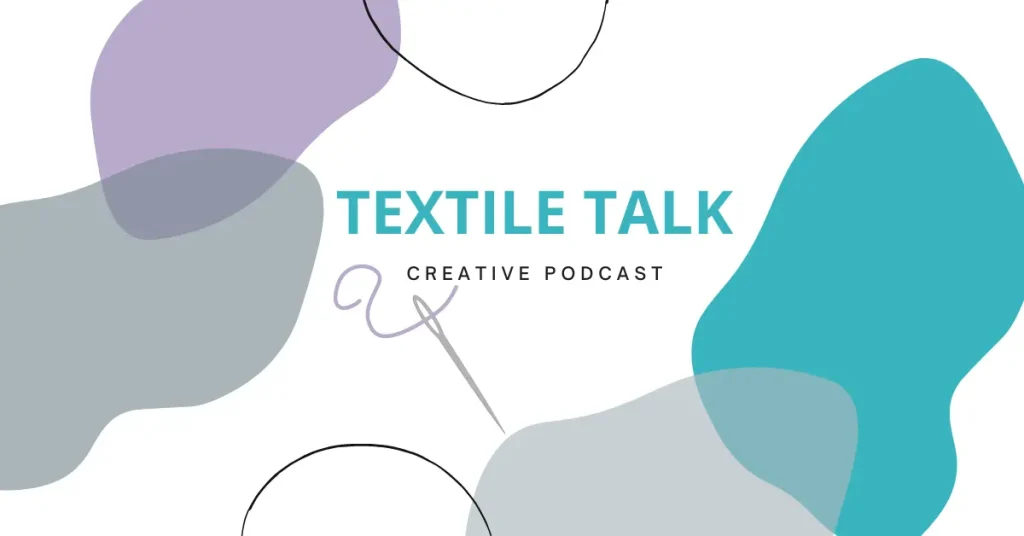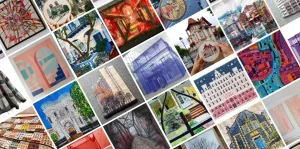Hello, everyone, and a very warm welcome to this textile talk podcast. I’m Gail Cowley and I’ll be your host today. Joining me for this episode is Zoe Ingram, who is a freelance artist, designer and illustrator based in Edinburgh, Scotland.
To give you some background to Zoe before we begin our conversation, she has an honours degree in industrial design for textiles and that’s with a print specialism and enjoys a career in graphic design and the creative arts. Spanning over 20 years. Zoe now focuses on illustration commissions and personal work. She loves traveling, trying new foods, and enjoys lifting weights in the gym.
In her work, nature is Zoe’s main source of inspiration and she uses a range of techniques in her work, both traditional and digital. Represented by her US agent, Lilla Rogers studio, Zoe has happily been with the agency since 2013, when she won representation with her agent in a global competition. You’ll find Zoe’s work on fabric, stationery, greeting cards, magazines, books and home decor products. Zoe is also the author of Oh My Goo Ash and Drawing for the Soul, both of which are published by David and Charles.
Textile Talk with Zoe Ingram
Zoe Ingram
Gail: Thank you so much for joining us today, Zoe, it’s lovely to be able to chat with you. Could I start off by asking you to tell us a little bit about your career journey? I know that you started off with an honours degree in industrial design for textiles, but if you could tell us a little bit about how things progressed from there, that would be fabulous.
Zoe: Yeah. So, yeah, I studied in Galashiels and I finished up in 1997. I think it was. At the time, it was kind of like there was no Internet at that time, so finding jobs in that industry was quite tricky. And so after, at the end of my fourth year, we went to new designers in London and I was picked up by an agent there who were based in Switzerland. And so they would send out briefs to me, sort of like trends boards and stuff like that, and I would work on them at home. I had a home studio, so I was working at home, and then I would mail everything off in the post to Switzerland. Yes.
Gail: Oh my goodness.
Zoe: So it was really tricky. It was really difficult to get that feedback quite quickly. And I was basically working in my bedroom at the time because I was still living at home, having just finished college. So I did that for about six months and it was just really tedious. And so I decided that it wasn’t for me at that time. So I ended up working in retail after that for about two years, two or three years. And I kind of knew that that wasn’t what I wanted to do either. But it was a way for me to earn a little bit of an income, and the only other options were to move abroad at that time, or London. And I really didn’t want to live in London.
So, yeah, it was retail for me, which was great, actually. It was quite nice to do that for a little while. But after a couple of years, I got sort of a little bit tired of it, shall we say. And I wanted more. I wanted to do something I had trained to do something a bit more creative. So, because I knew that there weren’t that many textile design jobs in Scotland at that time, maybe there was, and I just didn’t really know where to look. I thought that diversifying a little bit might be the way to go. So I took it upon myself to go to night classes to learn Photoshop, which I didn’t really have any sort of computer skills at all. It was all brand new to me. I bought myself a little iMac, one of the original blueberry imacs.
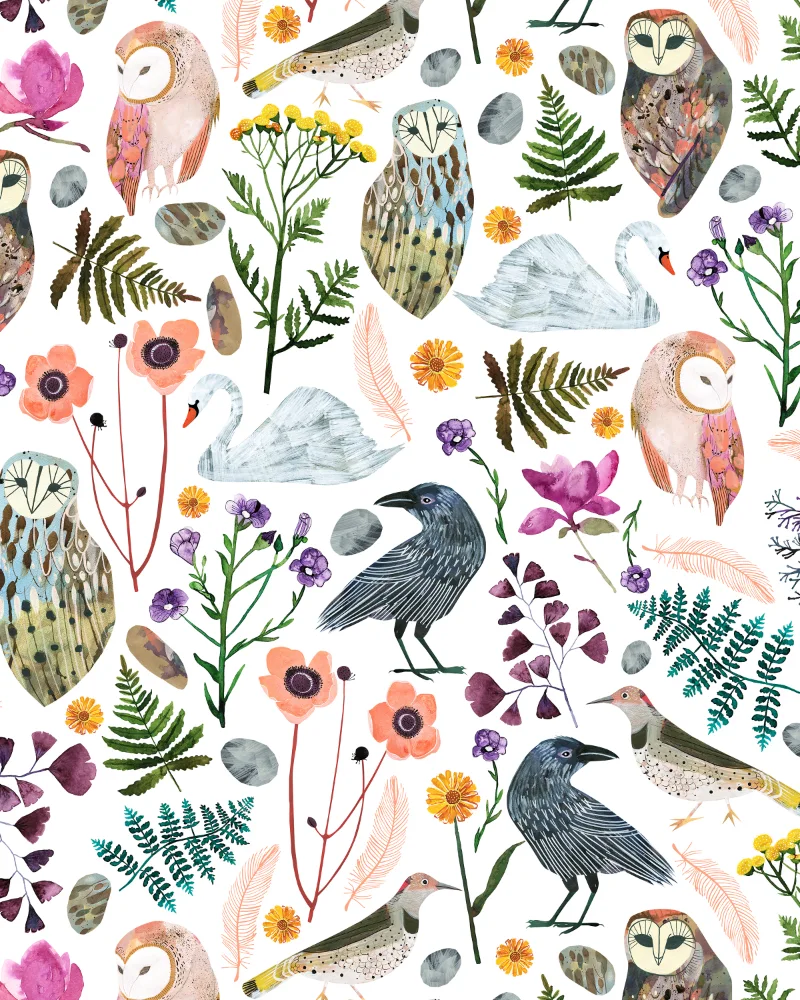
Gail: Yes. Which I remember.
Zoe: Yeah. And it was terrible. It was so bad thinking about it now. But, yeah, I did that and I just practiced all that kind of stuff, Photoshop and illustrator, I think it was called freehand at the time. And I managed to get hold of some software to put onto my own Mac to practice. And I actually loved it. I loved the whole digital part of it. So I decided that me and every design agency in Edinburgh that I could think of or that I could find to see if there were any openings there.
Luckily, I got an opportunity at a company called Tayburn, who are based in Edinburgh, and they do advertising, and at the time, they had different sort of branches to their business. So I was working with the corporate team, doing a lot of annual reports and financial brochures and stuff like that. But I started as a junior and I kind of learned the ropes that way, which was great. I absolutely loved it there. And the team that I was working with at that time were great, and I learned so much from them that I probably wouldn’t have learned on my own. Being in that situation was really good.
Gail: Learning makes a difference, doesn’t it? Who you work with. It does make a difference, absolutely.
Zoe: I did that for. I think I started there in 99, and then within the company, I moved to the web team, which was very new as well. It was a new department. So I started sort of learning the ways of the web and doing that, and at that time as well, because it was all quite new. It was designing the graphics and doing the back end stuff and everything else in between. And nowadays they have specialist teams to do certain parts of any web application or whatever. So I did get quite a range of skills, I would say there. Yeah, I did that for a few years, and then I moved to a different company and I was there for six years. And then myself and my family, we moved to Australia in 2009. So I’d had two children by this point as well. So when we left in 2009, my youngest was just a baby, so I was kind of like, still on maternity leave.
Gail: Was it intended to be a permanent move or something?
Zoe: Temporary, I think we didn’t really know. We sort of decided that we wanted to do it, and then we sort of said to each other, if it doesn’t work out in five years, we’ll come back. But it kind of did. It was good. And we were there for nine years. I was there right after the first couple of years, I got a little job over there working do more web design, and, and I was made redundant from that job about a year after I started. And then I started working just casually for another company. So I was working at home a lot, and it was, again, more web, more web stuff. And then in around, I think it was 2013, it was. I think I came across Lilla Rogers, who is my agent now. She’s an illustration agent in America, and she was running a competition to recruit her next artist, basically.
Gail: That sounds exciting.
Zoe: Yeah. I think in the past she was getting submissions from people all the time, and it was really difficult to sift through them all and pick people out. So I think her idea was that she was running courses at the same time and she was basically talent spot. And I think to see who our next artist would be. And I just saw that as an opportunity to, a) learn and b) it might just happen. I might just get that representation. And I was getting to the point where I kind of really missed the creative side of my creative side. Basically, web design was good, but the creativity wasn’t always there.
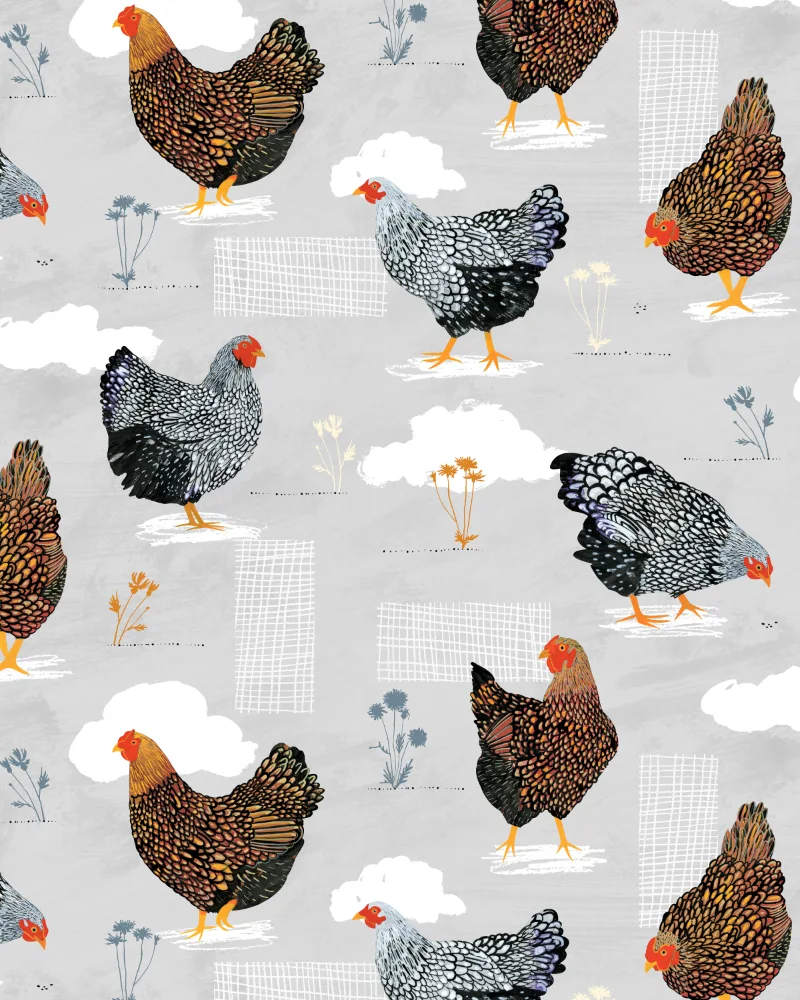
Gail: I imagine that you’re very much dictator perhaps isn’t the right word, but the requirements are very much the clients, aren’t they then? Not as creators.
Zoe: Yeah. And the briefs are a lot tighter and more, maybe more corporate and rigid, unless you put less of yourself into it with illustration. It’s more about your unique style. Basically, it’s what someone, like a client would come to you for your style. And while that might be true for certain design agencies, being a designer in that agency is different. I think you don’t always get to show off your creative flair.
Gail: Yeah.
Zoe: So I did the courses and entered the competition, which was carried out over, I think it was like three months or something. There was three different rounds off the competition and there was about 1500 people had.
Gail: Oh, my goodness.
Zoe: Wow. I got to the final and I won. She picked me. Wow.
Gail: Oh, that must have been so an amazing moment for you.
Zoe: It was amazing. It was very surreal and I felt had that real sense of impostor syndrome. Oh, my God. Did she pick the right person?
Gail: Isn’t it strange how we can’t just accept that we have talents and we deserve to be there? I think everyone’s the same, but it’s strange human quirk, isn’t it?
Zoe: It is. And to this day, I still get those feelings sometimes. Yeah. So that was me. So that was towards the end of 2013, and from there, I’m still with the agencies who have been there just over ten years now, and I was basically just flung into the world of commissions and licensing and working for different clients. And it’s been a ride. It’s been great so far.

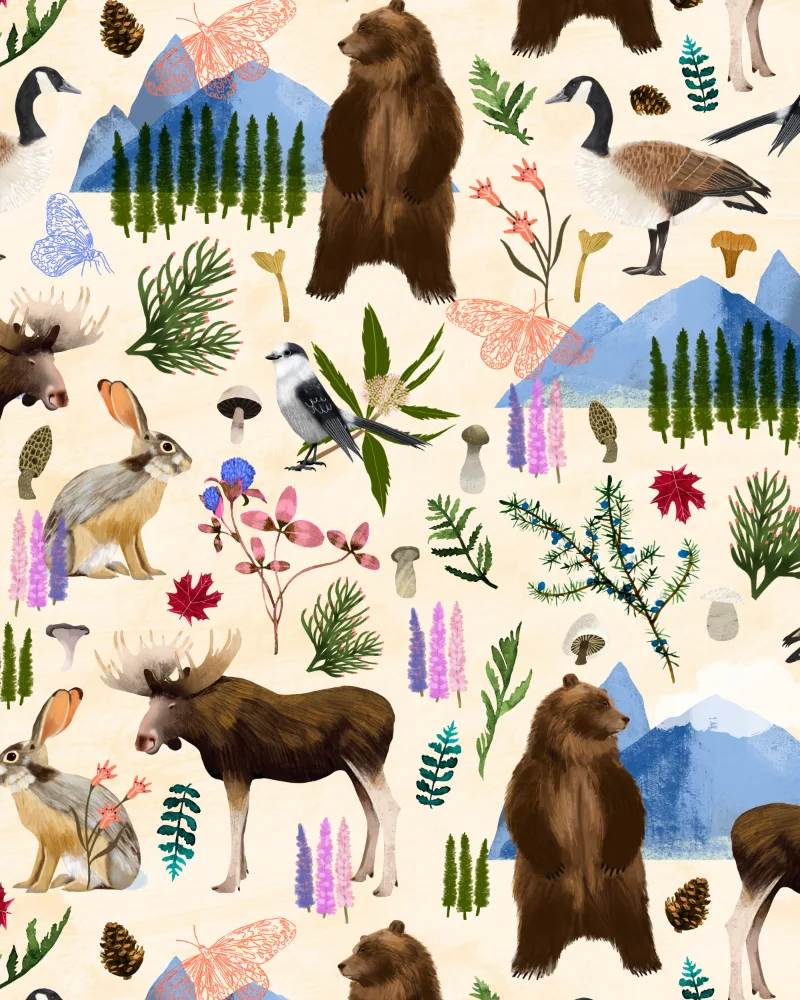
Zoe Ingram’s Clients
Gail: I mean, just looking at the list of clients on your website, you’ve worked for some mean. I’m just picking out a couple here. Ikea, David and Charles, the book people, Penguin, Harper Collins. There’s just hallmark. There’s just so many isn’t.
Zoe: I think, you know, Lilla Rogers does have a good reputation, and a lot of big publishers and clients go to her because they know that they’re going to get good artwork. And that’s not to say that there’s not other good agents out there, but I think she’s very well known in the industry and has a really good connections with a lot of clients.
Gail: How does it work, Zoe? If you get a commission from face, just randomly, a book publisher, how prescriptive is it? Do you have a lot of your own input or. I just wondered how it worked.
Zoe: It varies. It does vary a lot. Depending on the publisher and maybe the author as well. For example, at the moment I’m working on a couple of books. One of them have pretty much free rein and the other one is a lot more directed. I would say they know exactly what they want and it depends, really, on the job.
Gail: Yeah. Which do you prefer? Do you prefer to have more direction or to be less, more to your own devices?
Zoe: I think if the concept is strong, the manuscript is strong, and I get a real good feel for it. I’m quite happy to come up with things on my own, but if it’s not as clear, it helps to have a good, clear brief on exactly what they want to be in certain places throughout the book. And, yeah, it just depends. Yeah, a picture book at the moment. And so I’m kind of like just doing. It’s all coming out of just from me, but the story is very strong and all the information that I need is in the story.
Gail: So your first action is obviously to read the book.
Zoe: Yeah. You have to know about what you’re actually going to be illustrating. So it does help to read through and make notes and highlight anything that jumps out. If you are sort of left to come up with ideas on your own, it’s helpful to go through the manuscript and highlight certain words or certain objects that, you know, if there’s objects or animals or whatever it is.
Gail: I know that you do quite a bit of mixed media and digital applications. How does that work in practice? How do you sort of go about bringing the two together?
Zoe: So more recently, I’ve been doing a lot more work on my iPad. And that is great from the point of view that it’s quicker. It allows me to experiment more. And, yeah, I can take sort of like, I don’t know, maybe sort of textures that I’ve hand painted or hand drawn, scan them and take them onto my iPad and use them as textures. Or I can do certain elements with paint, scan it and take it into the iPad and combine two that way. That’s usually how I do it these days. Before, when I first started, I would use a lot of line drawings, like with fine liner pens, and then they would be scanned and converted into vectors on an illustrator. So it really just depends. And sometimes I’ll take stuff that I’ve done on my iPad and take it into Photoshop and create patterns or whatever that way. So it just depends. But the scope is there to really play with both mixed media like digital and traditional.
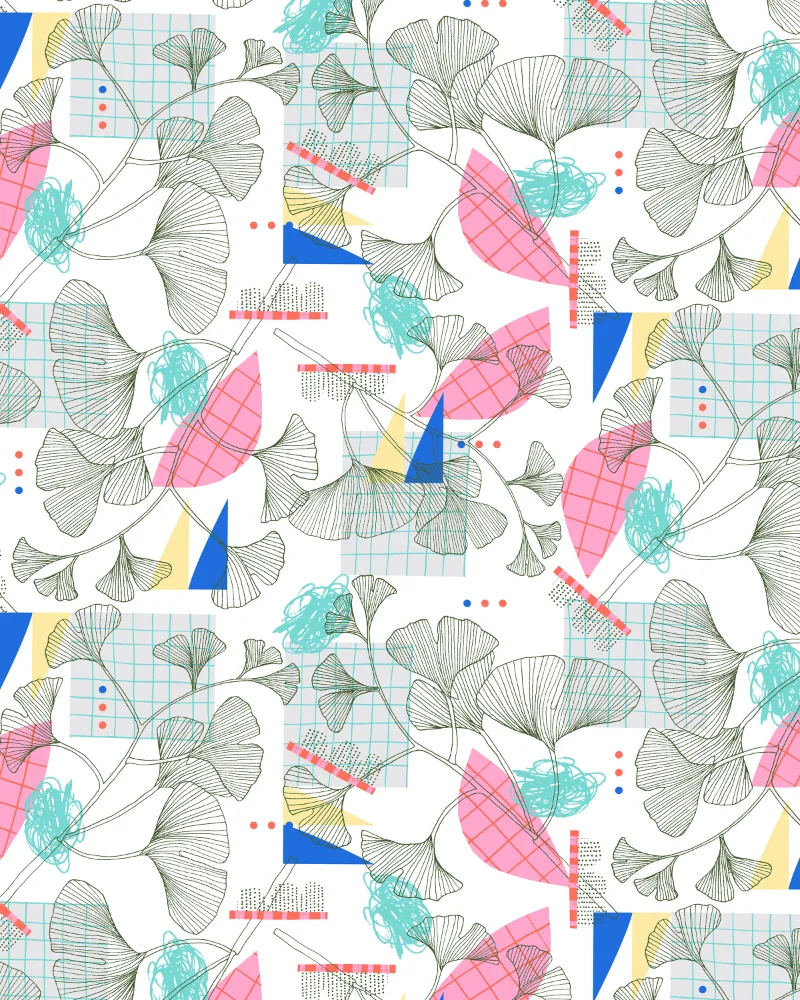
Gail: Do you have a particular program that you use on your iPad?
Zoe: Yeah, I use procreate and affinity sometimes as well. I’ve actually just started using affinity designer. That’s quite new to me. It’s quite good for patterns and stuff like that.
Gail: I suppose it must be very portable as well if you’re working on an iPad.
Zoe: It is, yes, it’s good. I can take it with me if I’m going away anywhere or if I just want to sit downstairs and watch a movie, I can stick a movie on and sit and draw.
Gail: That’s a nice way to work, isn’t it?
Zoe: It is, yeah. Sometimes I don’t want to be stuck in my little office.
Gail: No, I’m sure. Do you ever take your work outside?
Zoe: Not really outdoors, no. But sometimes I just go to a cafe and sit and have a coffee, because sometimes I get, if I’m feeling a bit procrastinated, like if I’m finding a bit of a resistance to getting started on something, I’ll sometimes go out to a cafe. And that really gets me started because I’m there and I’m like, well, if I’m here having a coffee, I might as well just do something. But going outside with the iPad is difficult because the light, you can’t really see the details properly. Screen.
Gail: Do you find yourself attracting crowds when you’re out working, drawing? No.
Zoe: I don’t think anyone really knows who I am.
Gail: No, I just thought that sometimes people are very interested in seeing someone else and doing something artistic. Yeah.
Zoe: No, I’ve never really been that bothered by anyone. They just sort of leave me to it. And mind you, I’m usually sort of hiding away in a little corner.
Gail: So it’s in the back of your mind someone might see?
Zoe: Yeah. If I’m working on client work, I have to watch that I’m not sort of displaying it in front of people when it’s not supposed to be seen until it’s published.
Gail: I see. So there’s a sort of a secretive aspect to it, really, in that you can’t talk about it until it’s actually been.
Zoe: Yeah, in most cases that’s true.
Gail: What sort of mediums do you prefer best?
Zoe: So I like traditional mediums. I like ink. I like using acrylic inks and gouache. But I do have a ton of different stuff. I’ve got, like, markers and pencils. I like using pencils for details at the end. But, yeah, I like using inks for painting and also for doing lettering or with a nib pen. And also just for doing line drawings because it’s really quite free line. It’s nice. And then gouache for, if I’m doing painting animals or something, those lines.

Gail: I can see there’s obviously a huge mixture in styles as well within your work. Is that in response to a brief, or do you just enjoy varying up style that you use?
Zoe: I enjoy varying it. I know a lot of people and a lot of illustrators really work on honing their style, and they get it so perfect and recognizable that that’s their style. And I totally get that. But I like to just do whatever feels right for the job or for what the vision that I’ve got in my head. I like to kind of adapt a little bit. I don’t like to pigeonhole myself into one sort of certain style, although people do say that they can see the common style throughout my work, even if it’s slightly different, that they can still see that it’s my hand that’s done a certain piece or whatever.
Gail: I know that you design for textiles as well, don’t you?
Zoe: Yes, I do. I mean, that’s really how I started off, doing repeat patterns and stuff for print.
Designing for Textiles
Gail: I just wondered if there were more considerations with designing for textile than there are, for example, for doing a book illustration, certain criteria that you have to work to.
Zoe: I mean, a lot of the textile stuff that I do is purely for myself, and I sell a lot of stuff on spoon flower. In that sense, when I’m designing a pattern for textiles, I think it’s always a good practice that if you’re working on a certain theme, to have as many different drawings or paintings that you can pull from to put into one print, you could do it like, say it’s a theme on woodland animals. If you have just a rabbit and a flower, it could make a nice pattern. But if you have more icons or elements, it makes for a much more interesting pattern, and you can do a lot more with it. And it also allows you to work on sort of coordinates that might go with that as well. So I would say that actually, in some of my books as well, that I do approach them that way, where maybe the end papers of a book have a pattern on them. So I’ll think about that in the same way. A lot of the work that I do involves painting or drawing certain elements individually rather than full scenes. For example, my first book of birds or my first book of farmed animals that I do with walker books. There’s a lot of different elements throughout the book, and the end papers are all sort of, like, patterned with everything.
Gail: Yeah. So it sort of brought all the elements together in one place.
Zoe: That’s right, yeah.
Gail: Often, I know a lot of our followers will perhaps be into patchwork, patchwork and quilting, so they’ll be used to the concept of perhaps having a couple of larger designs, some smaller designs that would act as. Perhaps as borders, or is that the way that you would think about designing for textiles, larger and smaller prints?
Zoe: Yeah, I think if I was doing a collection with a fabric company, yes, I think that’s definitely the way that it goes. But with spoonflower, it’s a little bit less, not rigid, but you can basically do whatever you want.
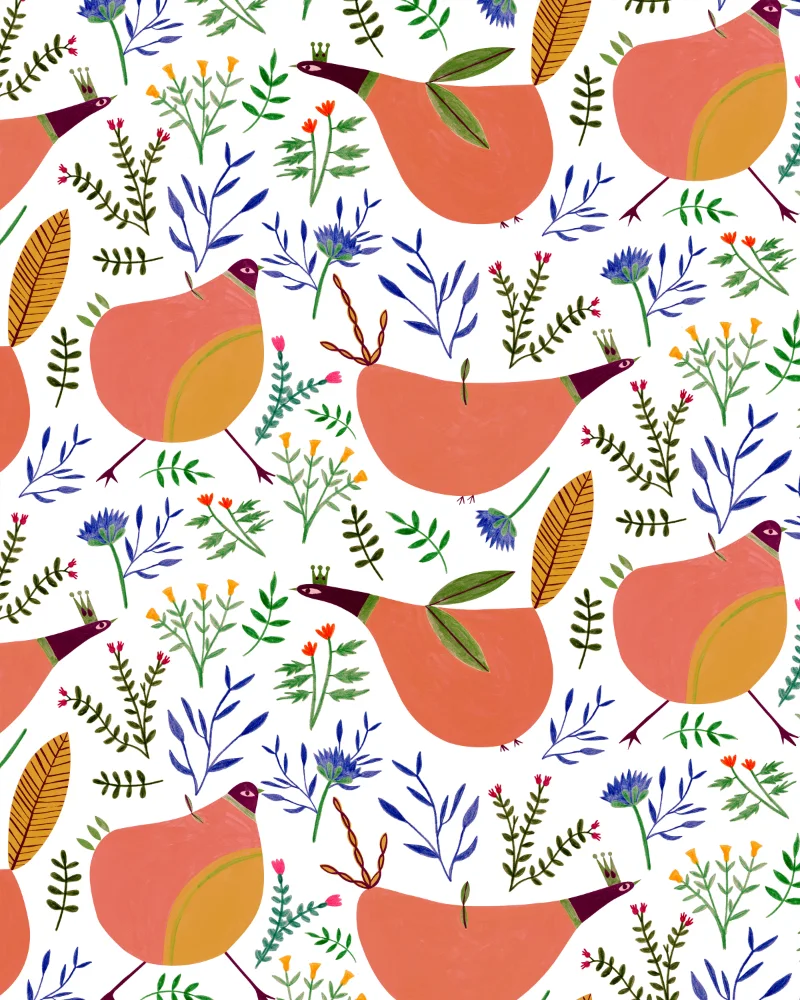
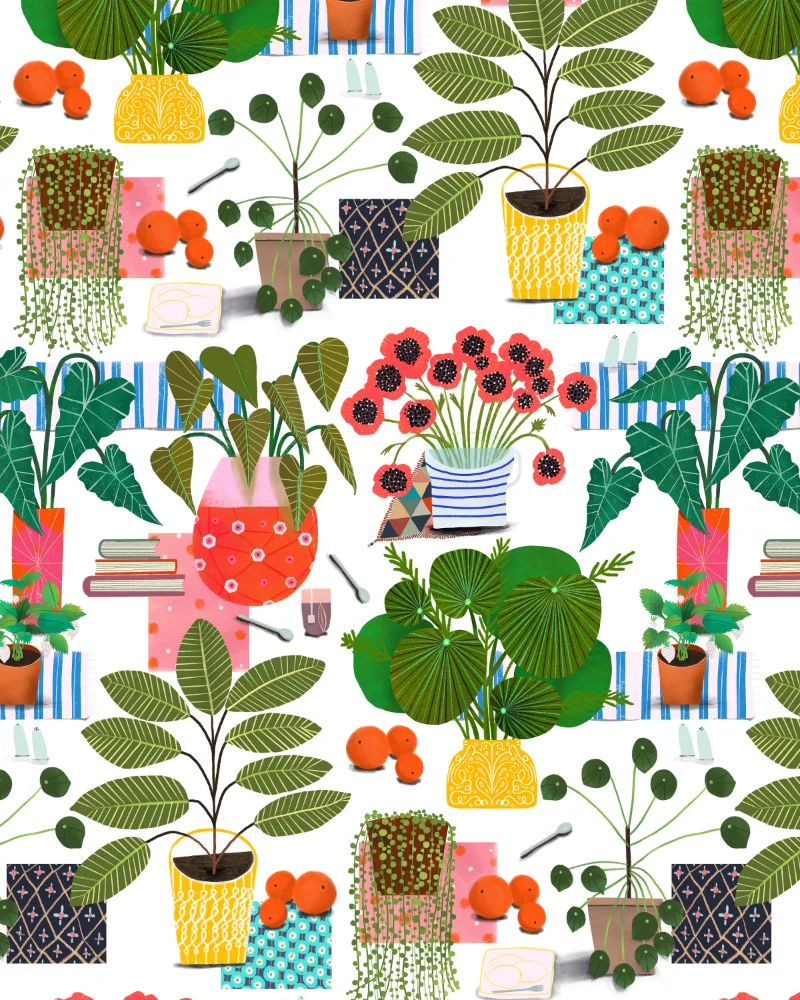
Gail: Right.
Zoe: So I don’t necessarily have to create a full collection with two main prints and four coordinates or whatever. I could just do, like, one main print for spoon flower, and if I felt like it, maybe do one or two coordinates or none at all. It all just depends on what I feel like doing.
Gail: That’s nice, isn’t it? Yes, that is lovely.
Zoe: It is. Yeah. I think a lot of the time, yes. Quilters do look for coordinates, so that is definitely always in my mind. But sometimes it’s quite nice just to do just one hero print, one design.
Gail: And do you have any particular area or products that you enjoy designing for above?
Zoe: Like, I’ve done a couple of collections for home decor with a company in America, and I really love doing that because it all stems. It’s actually kind of similar to designing for a printed textile. So same sort of process. You would get all your different. You’re designing a theme, basically, and say it’s birds, winter birds or something. So do maybe, like, five or six different birds and some winter foliage, some berries, all that kind of thing, and put it all together and come up with some ideas for products as well. And this is all kind of new to me from doing the courses with Lilla Rogers. So I really love doing that. I really love doing books as well for kids.
Gail: Yeah. So it’s particularly children’s books, I suppose there’s more illustration in them, isn’t there?
Zoe: Thinking about it, yeah. And they’re usually nonfiction as well, the books that I do. So more factual type books and less of the storybook picture book for me. Yeah.
Gail: So, for example, something like a children’s encyclopedia.
Zoe: Yeah, something like that. That would be an excellent job.
Gail: Yes. There’d be plenty in it.
Zoe: Would universe? Yeah. Stuff like that. Yes. I can’t really say what I’m working on at the moment, I don’t think. But that’s the kind of thing that I’m doing right now. It’s all very factual and fun as well. It’s quite fun for kids.
Gail: So then the style, I suppose, has to change for that because it has to be presumed quite precise.
Zoe: Yeah. I mean, some of them are like the illustrations, to be a bit more realistic, and some are open to them being a little bit freer with a bit more quirk. So, again, it just depends on the job, really, and what they are looking for.

Nurturing Creativity
Gail: I know that our students and followers, they often think of drawing and design as a bit of a black art, and I think that they often believe that it’s a gift that you’re born with, rather than one that you can develop by working at it. I wonder which view you subscribe to.
Zoe: I mean, I can understand why people think that way, but I don’t believe that that’s true at all. I think it all comes from if you have that urge to want to draw in the first place, and then it really is just about practice. I’ve been doing this for ten years now, and my style has kind of changed and evolved over the years, and it wouldn’t have done if I didn’t put in the hours. It really is just about practice, and I think that anybody could draw. And a lot of times people think of drawing as being very realistic or photorealistic, and if they can’t do that, then they can’t draw. But I think that if you can hold a pencil and put it on a piece of paper and make some marks, then you’re drawing. That’s a drawing.
Gail: I think people often get very discouraged, don’t they? Because they try and it doesn’t look.
Zoe: Like it doesn’t come out, how they even envisage it. First of all, that frustration is there. And I think people maybe just expect it to be that perfect drawing straight away. But a lot of times you have to refine and come at it from a different angle. Or when you see some illustrators doing character development for books, they’re doing sketch after sketch after sketch after sketch to get it just right. And that frustration is definitely there. And I think the people who eventually are seen to be good at drawing are the ones who stick at it and just keep going and practice. And by no means am I, like, perfect drawer.
Gail: I think most people would think you were.
Zoe: No, I mean. I mean, I look at people who draw super photorealistic stuff and I’m thinking, how on earth do they do that? And it looks like it takes hours and hours and hours as well to do one drawing.
Gail: I always think when I look at that, that as a client, I suppose if you wanted something that was so much like a photograph, wouldn’t you just take a photograph? Surely part of the reason for drawing and design is that you are inputting some of your own individual style into it.
Zoe: Yeah, I think with illustration, that’s definitely the thing. But then some people appreciate the time that it takes to do one of these photorealistic drawings and just the patience and the skill to get all the tonal values correct. And it’s just different. I think it’s just different from illustration in that sense, that with illustration, you have got your recognizable style, and that’s why people come to you for work.
Gail: Do you have any advice that you could give to someone wishing to improve their drawing and design skills? What would be the thing that if someone really wanted to work at it, that they could most usefully do?
Zoe: Really, it’s just practice sketchbooks. Just use sketchbooks because they’re not quite so scary. It’s like when you’ve got a blank page with beautiful paper in front of you, you don’t want to put the pencil on the page because sketchbooks are great drawing. Just anything and everything that you can see just to practice and get better, proven your style. I guess.
Artistic Development
Gail: We’ve just sort of talked about the fact that it’s very easy to kind of look at what you’ve just done, particularly as a beginner, and want to give up because it’s not what you hoped it might be. Do you have any words of wisdom that might keep people on with trying? Because, as you say, it’s something they have to go back to in a sketchbook, and that does mean them practicing over quite a long period. Is there anything that can keep them going during that time if they’re not happy with what they’re producing?
Zoe: Maybe. I don’t know. Maybe getting some feedback from someone. I guess it depends on what level the person is. If you’re at school and you can get feedback from a teacher or a lecturer or peers as well, sometimes it’s good to look at your fellow students and ask them for feedback. Yeah, that’s a really difficult question, actually.
Gail: I’ve spoken to a lot of students of mine that has been put off drawing or any art, actually, quite early on. I think somebody has perhaps been a little bit cruel about one of their early pieces, and they just then get it into their mind that they can’t draw, that they can’t do it. And I think that’s actually quite difficult to overcome.
Zoe: It is. I think that’s where a lot of people will stop. And sometimes that happens from a very young age as well, I think. And that’s why people have this concept that they can’t draw. And because somebody said something to them or laughed at their drawing or whatever made them feel bad about what they’d done, even if they initially thought it was good. And I think you have to just trust yourself and trust your judgment, and don’t listen to anybody else unless it’s someone who knows what they’re talking about. And usually the people who know what they’re talking about will deliver feedback in a more positive and constructive way. I think so. That is difficult to overcome. Definitely it is.
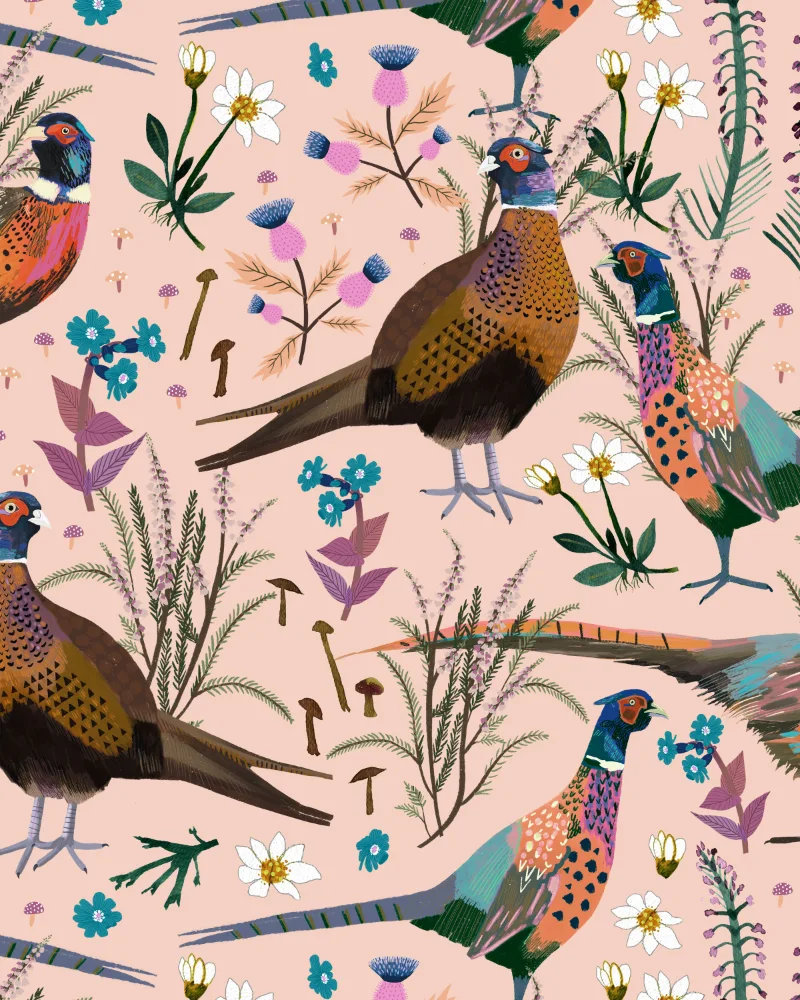
Gail: And you’re right. I think it does often happen at a very early age. I remember one student telling me what I thought was a horrendous story, really, about. She was in primary school and they’d been drawing in class, and the teacher had taken one look at hers and told her to go and stand in the waste paper basket because she was rubbish. I hastened to add that it was an older person and it was quite a while ago. Hopefully that wouldn’t happen today, but it’s sort of quite an extreme example. People can be put off.
Zoe: I would have been put off if somebody had done that to me. Wow. Yeah. I can remember when I was very young, even things like with coloring book, when I managed to draw with in the lines without. When you’re very young, you don’t have that control, so you do tend to go outside the lines and stuff. And I can remember being so proud of myself that I managed to get the pen just in the designated space that it was supposed to be in. I can also remember another time where I spent, I don’t know, weeks, months drawing on sheet after sheet after sheet of paper, these little very 80s inspired fashion design drawings. And so they were very sort of like angular, triangular bodies and faces, and I just thought they were like the bee’s knees. And nobody told me any different. That was the thing. Nobody said, that’s terrible, or, what are you doing that looks silly, or. So I never, ever got that kind of discouragement. Understand? Somebody has had that happen to them that would be quite detrimental to their confidence.
Gail: I think it’s something we. I don’t know why this is, but I think as individuals, we tend to take it quite personally with drawing or design in a way that perhaps we wouldn’t if someone said, well, your patchwork is not very neat, is it? Go back and try and try a different joining method or whatever. We just accept that somehow drawing is personal. It feels more personal, almost like an attack on you as an individual.
Zoe: Yeah, I think it’s because it’s like you’ve done your best and there’s really not more that you could have done. And so when someone criticizes it, then it is a bit more personal because you’ve given it your all. And yes, that’s rough.
Applications and Software
Gail: At the beginning of the episode, you talked about using Photoshop and that sort of thing. There’s some of the different programs that have come along, and I know many of our students have the thought that if they could use those, they wouldn’t need to draw. I wonder if you have any thoughts on that.
Zoe: I mean, I know there are a lot of working illustrators today who only use digital media. They don’t use their hands, they don’t use traditional media at all.
Gail: Yes.
Zoe: So it can be done. I think the danger with it is that a lot of it can start to look seamy. Yeah. I think having that skill of being able to produce something with traditional media is very beneficial.
Gail: So you would sort of look on it, perhaps, as the basics are needed there for you as an artist, to be able to produce something, but you can hone that within some of the programs.
Zoe: Yeah, I think having that basic foundation is definitely a good thing to have, because even if you do decide to do just digital, solely digital work, you still got that basic foundation, and you’re not relying as heavily on the tools within the app or the software to produce the shapes that you need or whatever. If you’re still using your hand to draw on the app more sort of organic shapes rather than very geometric shapes, then, yeah, I think it’s definitely a good thing to have that skill.

Gail: I suppose all of the various apps have cut out quite a few processes, haven’t they? Whereas perhaps in years gone by, we’d have had to have copied the same thing over and over or enlarged things, and that would have been done by hand. Now we can copy and paste, change colours easily, that kind of thing.
Zoe: Yeah. Don’t get me wrong, digital tools are amazing, and they are big time saver. It’s a big time saver for me sometimes if I’ve got a tight deadline and the client wants 20 illustrations by x date. And I know that I can only do ten in that time, traditionally, because you’ve got to wait for paint to dry and takes a lot longer. And also, if you make a mistake with traditional, it’s harder to correct, whereas with digital, the process from start to finish is so much more streamlined, quicker. If you’re working on a job that has a deadline like that, it’s a godsend sometimes.
Gail: I know that you’ve done, certainly one book on drawings for the soul, where you sort of take people, beginners, through simple drawings. I think really with the thought of. Would you call it mindfulness? I’m not sure. Yeah.
Zoe: Drawing for the soul is basically for anyone who just wants to slow down a bit and use drawing as a tool for meditation or just to have some time just to yourself, just to relax and just enjoy the act of drawing. It doesn’t have to be perfect, doesn’t have to be this masterpiece. It can be just something really repetitive or simple, or you can use your left hand so that you take that sort of idea of perfection out of the equation altogether. That’s if you’re right handed. And I’m saying, yes, it’s projects within that book that I think are really good for just switching off and finding that sort of little flow moment that you can just be in the zone.
Gail: And it’s a nice way of getting people started, isn’t it? Hopefully putting their feet on that path.
Zoe: Yes, definitely. There’s a lot of exercises in there that you can do that kind of just hopefully eases someone who’s new to drawing into it in a gentle way.
Gail: What’s next for you? I know that you can’t talk about specific projects, but do you have any more of your own books in the pipeline?
Zoe: Yeah, so I’m working on. I think I’m doing four books at the moment.
Gail: Oh, gosh. Do you like having a few on the go at once?
Zoe: No, I don’t. It’s just kind of happened like that. They’re all sort of staggered and had a little bit of an overlap, but they all seem to have. Just with the timelines, they all seem to be all at once now, so that’s a bit stressful. And I’ve got another book starting, another book later in the year, but as far as personal work goes, I’ve got a project in mind that I want to tackle, but it’s quite big and I think I’m just going to chip away at it over the next year. I think it’s going to take me a while to do it, but I don’t really want to say too much about it at the moment because I don’t know if it’s going to come to fruition, but I would like to get to a point where I could pitch it to publisher. Yeah, that’s what I’ll say.
Gail: When you do that. If you sort of originate something for yourself and pitch it, as opposed to being commissioned, what do you have to give them? I mean, do you have to give them a few pages or how does that work, that process?
Zoe: Well, I haven’t actually done it before, to be honest.
Gail: Okay.
Zoe: This is my first time, but I kind of have an idea of what I would need to present. And so I would have the concept laid out in words and also visuals. So I’m kind of working on stuff at the moment, the visual part of it, and so hopefully I would have, if not all of it done, but some of it and then work on the rest once a deal has been negotiated or whatever.
Gail: Yeah, I should think you almost want to know, don’t you, that somebody is going to pick up on it? Because otherwise it sounds as though it would be a lot of work to just.
Zoe: Yeah, it would be a lot of work, but I would still do it, I think, because I think if a publisher doesn’t pick it up, then I would maybe think about doing it myself.
Gail: Like myself, you obviously know a lot about that industry and you know what will work and what won’t, so I could well understand that.
Zoe: Yeah, I know a little bit, but I think I would still have to do some research into how I would get it printed and all that kind of stuff.
Gail: So do you ever do a sort of gallery show or is that not really your scene?
Zoe: I haven’t ever done a gallery show, but it is on my bucket list. It’s been a dream of mine for so long to have a studio where I can just fling some paint around proper on canvas and do actual paintings, but I don’t really have a space for that right now. But yeah, I would absolutely love to do that in the future. And it’s something that I’m thinking about more and more as the years go by.
Gail: Yeah, on the bucket list for the future. And I wonder, just as we’re sort of coming towards the end of the podcast, is there anything that. Did you have a funny story or an anecdote that you’d like to share with us? I think people that work with the public generally have something.
Zoe: I’ve been racking my brain trying to think of something.
Gail: Oh, I’m sorry, did I put you on the spot?
Zoe: I guess probably the most awkward thing that’s happened to me while I’ve been doing illustration is being on with my agent. She does a retreat every year, so when it was during COVID we had it online. And so she invites a lot of clients to come along and we do sort of like little short sort of chats with the clients basically, and show them their work and stuff. And during that time, it was my first ever time, and it got to the point where we’re talking to all the different clients. I had a power cut. There was a power cut in my house, and so I just got cut off completely and I got back on again. And then the same thing happened again. And it happened, I think it happened twice, three times, and it’s like all the times that you could. That’s kind of. But I think they understood that it was just one of those things.
Gail: Yeah. Zoom must have made such a difference to that whole. I suppose. Can I call it a commissioning process? But people that obviously want to commission you and yourself, being able to get together and talk, that would have been almost impossible, wouldn’t it, at one stage, yeah.
Zoe: And to have so many people all at once as not like, my agent’s in America, in Boston, and she used to have the retreats in person, so it wasn’t always possible for people to get there physically, just due to costs and time. They can’t be away from their kids or whatever. So having that kind of thing online is great. Yeah.
Gail: I suppose. Even just having an agent in Boston, it must make a huge difference to the closeness of your relationship with.
Zoe: Mean. When I was in was obviously, I was further away, but now that I’m back in Scotland, we’re a little closer and a little bit easier to get over there. Although I’ve still not been yet. But one day.
Gail: How have you found it since you’ve come back? Has it been after nine years in Australia? Just the weather must have been a shock.
Zoe: Do you know what? I actually don’t mind the weather here. I quite enjoy the seasons, the different seasons, and it was so hot over there as well. It was stiflingly hot sometimes, so it was nice to come here and be a little bit cooler and especially my age, going through the menopause and hot flushes and all that.
Gail: Yes. I was actually talking to somebody the other day who’s based in Australia, and she was telling me that she’d never seen snow. I’m sure you won’t be able to say that, will you, in Scotland?
Zoe: Well, I’ve seen snow, but my kids, like my youngest especially, had never seen snow. It snowed on the day that they were born in February. But when we moved over there, my youngest was only eight months. Eight or nine months. So when we moved back, it snowed for the first time on their birthday, first year that we were back, and.
Gail: It was just to be wonderful to see their face.
Zoe: It was so good. It’s so funny to see just the mesmerized looks of wonder.
Gail: Oh, I bet. Zoe, thank you so much for today. It’s been an absolute pleasure having you on and chatting and hearing, obviously, a lot more about you and your just. And I know that the listeners will be really pleased to hear it as well, so thank you so much for that.
Zoe: Well, thank you for having me. Great to be here.
Gail: I’m so glad. It’s been a pleasure.
For more details please see her website or follow her on Instagram.
Key Takeaways:
Creativity is Developed through Practise: Zoe emphasizes that drawing and design are skills that can be developed over time through practise. It’s not just a natural talent but rather a result of dedication and hours put into refining one’s craft.
Start Small and Build Confidence: Beginning with simple sketches in a sketchbook can make the creative process less intimidating. By starting with manageable tasks, artists can gradually build confidence and skills.
Feedback and Support: Seeking feedback from peers, teachers, or mentors can provide valuable insights for improvement. Constructive criticism can help artists identify areas for growth and build resilience against discouragement.
Overcoming Negative Experiences: Negative experiences, especially early on, can have a lasting impact on an artist’s confidence. It’s essential to trust in one’s abilities and not let past criticism dictate future progress.
Personal Connection to Art: Drawing and design often feel more personal compared to other forms of creativity. Artists invest their emotions and efforts into their work, making criticism feel more intimate. Recognizing this vulnerability can help artists navigate feedback more effectively.
Balancing Traditional and Digital Tools: While digital tools offer efficiency and convenience, having a foundation in traditional techniques can be beneficial. Traditional skills provide a solid framework that can enhance the quality and authenticity of digital artwork.
Mindfulness and Drawing: Drawing can be a therapeutic practice, promoting mindfulness and relaxation. Projects aimed at slowing down and enjoying the process rather than focusing solely on the outcome can help artists find a sense of flow and tranquillity in their work.
